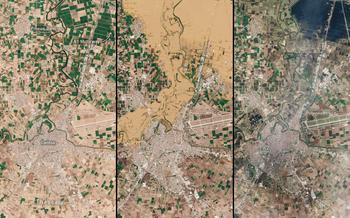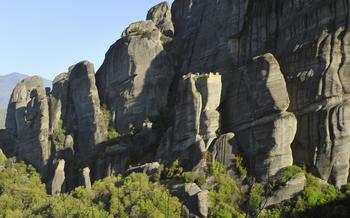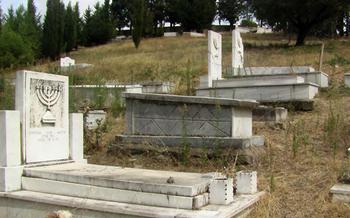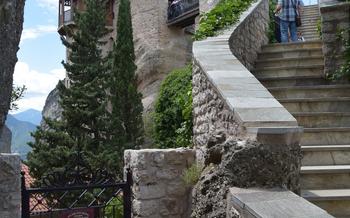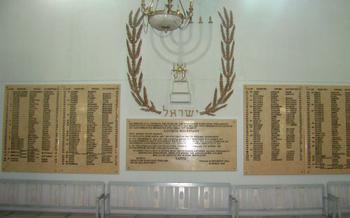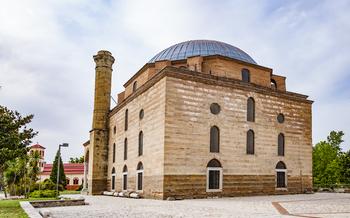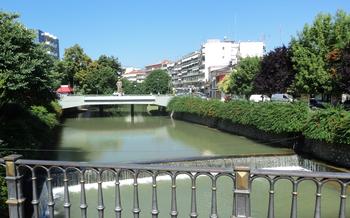
Monastery of Agios Nikolaos Anapafsas Meteora
- Atop the Rock Pillars
- History of the Monastery
- Monastery's Architecture
- The Frescoes
- The Museum
- Hours of Operation and Admission Fees
- Getting to the Monastery
- What to Wear
- Photography and Filming
- Tips for Visitors
- Nearby Attractions
- Where to Stay
- Where to Eat
- Prices
- Tips
- What to Buy
- Insider Tip: A Breathtaking Sunset
Atop the Rock Pillars
Meteora, an assembly of monumental natural sandstone pillars and home to some of the most breathtaking monasteries in the world, is an otherworldly landscape that seems to defy gravity. These astonishing rock formations, a result of the erosion of the soft sandstone by wind, rain, and earthquakes over millions of years, rise dramatically from the Thessalian Plain, their sheer cliffs and jagged peaks reaching heights of up to 600 meters.
Meteora's uniqueness is not only geological but also spiritual. Since the 11th century, these towering rock pillars have been home to a vibrant monastic community, with hermits and monks seeking refuge and communion with the divine in this remote and awe-inspiring setting. Legends and myths abound about these holy men, who were said to have scaled the cliffs with ropes and ladders, or even to have been miraculously transported to their lofty abodes by angels.
The geology of the area is equally fascinating. The Meteora rock formations are composed of sandstone, a sedimentary rock formed from the erosion and deposition of sand grains. Over time, the sandstone was cemented together by minerals, forming a hard and durable rock. The weathering of the sandstone by wind, rain, and earthquakes has created the unique shapes and features of the Meteora pillars.
The religious significance of Meteora is profound. The monasteries perched atop these towering rock pillars were built as places of retreat and contemplation, where monks could devote themselves to prayer and worship. The isolation and inaccessibility of the monasteries provided an ideal environment for spiritual growth and communion with God.
History of the Monastery
The founding of the monastery
The Monastery of Agios Nikolaos Anapafsas Meteora was founded in the 14th century by Saint Nikon, an ascetic monk from the Peloponnese. He was drawn to the Meteora region by the beauty of the landscape and the spiritual significance of the rock pillars. Saint Nikon and his disciples built a small church and cells on one of the pillars, and the monastery gradually grew over the centuries.
The name of the monastery
The monastery's name, Agios Nikolaos Anapafsas, means "Saint Nicholas of the Repose." This name was given to the monastery because it was believed that Saint Nicholas appeared to Saint Nikon in a dream and told him to build a monastery on the rock pillar.
Life of the monks
The monks of the Monastery of Agios Nikolaos Anapafsas lived a simple and austere life. They spent their days in prayer, meditation, and work. The monks were also known for their hospitality, and they welcomed visitors from all over the world.
The monastery today
The Monastery of Agios Nikolaos Anapafsas is still an active monastery today. It is home to a small community of monks who continue to live according to the teachings of Saint Nikon. The monastery is also a popular tourist destination, and visitors come from all over the world to see the stunning architecture, the beautiful frescoes, and the breathtaking views of the Meteora region.
Monastery's Architecture
The Monastery of Agios Nikolaos Anapafsas is a complex of buildings that includes the church, the refectory, the cells, and other auxiliary structures. The church is the most prominent building in the complex, and it is decorated with frescoes that depict scenes from the Bible and the lives of the saints. The refectory is where the monks ate their meals, and it is also decorated with frescoes. The cells are where the monks lived, and they are typically small and simple. The other auxiliary structures include a kitchen, a bakery, and a storeroom.
The buildings of the monastery are all made of stone, and they are built in a traditional Byzantine style. The church is a single-aisled basilica with a dome, and it is supported by four columns. The refectory is a long, narrow building with a vaulted ceiling, and it is supported by six columns. The cells are small, square rooms with a single window, and they are typically arranged around a central courtyard.
The architecture of the Monastery of Agios Nikolaos Anapafsas is a testament to the skill and craftsmanship of the monks who built it. The buildings are both beautiful and functional, and they have stood the test of time for centuries.
The Frescoes
The Monastery of Agios Nikolaos Anapafsas is home to some of the most impressive and well-preserved frescoes in Greece. These beautiful works of art depict scenes from the Bible, as well as the lives of the saints. The frescoes were created by some of the most talented artists of the time, and they are a testament to the skill and artistry of the Byzantine period.
The colors used in the frescoes are vibrant and eye-catching, and they have been remarkably well-preserved over the centuries. The themes depicted in the frescoes are diverse, and they include everything from the creation of the world to the resurrection of Jesus Christ.
The frescoes in the Monastery of Agios Nikolaos Anapafsas are a valuable and important part of Greek history and culture. They are a testament to the faith and devotion of the monks who lived here, and they are a reminder of the beauty and power of Byzantine art.
The Museum
The Monastery of Agios Nikolaos Anapafsas is home to a small but fascinating museum that tells the story of the monastery and its inhabitants. The exhibits include religious artifacts, such as icons, manuscripts, and vestments. There are also exhibits on the history of the monastery, including the founding of the monastery and the lives of the monks. The museum is a great place to learn more about the monastery and its significance.
The museum is located in a small building next to the church. It is open to the public during the same hours as the monastery. Admission to the museum is free.
History of the Museum
The museum was founded in 1960 by a group of monks who wanted to preserve the history of the monastery. The museum has since been expanded and renovated several times. The current museum was built in 2000.
The Importance of the Museum
The museum plays an important role in preserving the history and culture of the Monastery of Agios Nikolaos Anapafsas. The exhibits tell the story of the monastery's founding, its inhabitants, and its significance in the history of Meteora. The museum also helps to raise awareness of the monastery and its importance to the region.
Hours of Operation and Admission Fees
The Monastery of Agios Nikolaos Anapafsas Meteora is open to visitors every day of the week, except for Tuesdays, from 9:00 AM to 5:00 PM. The admission fee for adults is €3, while children and students can enter for free. There are no discounts available for groups or seniors.
The monastery usually closes for a few weeks during the winter months, typically from mid-December to mid-February. It is advisable to check the monastery's website or contact them directly to confirm the opening hours before planning your visit.
Getting to the Monastery
How to get to Meteora
Meteora is located in central Greece, about 350 kilometers (220 miles) from Athens. The easiest way to get to Meteora is by car. The drive takes about four hours. If you are coming from Athens, take the A1 motorway north. Exit the motorway at the Kalambaka exit and follow the signs to Meteora.
How to get to the Monastery of Agios Nikolaos Anapafsas
The Monastery of Agios Nikolaos Anapafsas is located on the top of a rock pillar, about 150 meters (500 feet) above the ground. The only way to reach the monastery is by climbing the steps that have been carved into the rock. The climb takes about 30 minutes.
How long does it take to get to the monastery?
It takes about 30 minutes to climb the steps to the monastery. The climb is not difficult, but it can be strenuous in hot weather.
Is there parking available?
There is a small parking lot at the bottom of the steps to the monastery. The parking lot is free of charge.
What to Wear
When visiting the Monastery of Agios Nikolaos Anapafsas, it is important to dress respectfully, as it is a religious site. This means avoiding shorts, tank tops, and other revealing clothing. Women should also cover their shoulders and knees. If you are not properly dressed, you may be denied entry to the monastery.
There are no specific exceptions to the dress code, but it is generally more lenient for children. If you are unsure about what to wear, it is best to err on the side of caution and dress more conservatively.
The consequences of not following the dress code can vary. You may be asked to leave the monastery, or you may simply be given a disapproving look. It is important to be respectful of the monks and other visitors, and to dress appropriately for the occasion.
Photography and Filming
Photography and filming are generally permitted within the Monastery of Agios Nikolaos Anapafsas Meteora, but with certain important restrictions. Visitors are encouraged to be respectful and mindful of the sacred nature of the site, and to refrain from capturing images that could be considered inappropriate or intrusive. The use of flash photography is strictly prohibited, as it can damage the delicate frescoes and artwork within the monastery.
Additionally, visitors are not allowed to film or photograph in certain areas, such as the altar, the refectory, and the cells where the monks reside. These areas are considered private and off-limits to photography and filming. It is essential to adhere to these guidelines to ensure the privacy and tranquility of the monastery's inhabitants.
Failure to comply with the photography and filming rules may result in being asked to leave the monastery or having your camera or phone confiscated. It is therefore crucial to be respectful and responsible when taking photographs or filming within the monastery grounds.
Tips for Visitors
When planning your visit to the Monastery of Agios Nikolaos Anapafsas, there are a few things you should keep in mind to make your experience more enjoyable and fulfilling.
-
The best time to visit the monastery is early in the morning or late in the afternoon. This will help you avoid the crowds and the heat.
-
The monastery is open to visitors daily from 9:00 AM to 1:00 PM and from 3:00 PM to 6:00 PM.
-
Allow at least two hours for your visit. This will give you enough time to explore the monastery's grounds, visit the church, and admire the frescoes.
-
The monastery is a holy place, so be respectful of the monks and other visitors. Speak quietly and avoid taking photos or videos of the monks without their permission.
-
Guided tours are available in English and Greek. These tours are a great way to learn more about the history and significance of the monastery.
-
The monastery is located in a remote area, so be sure to bring water and snacks with you. There are no shops or restaurants in the vicinity of the monastery.
-
The monastery is a UNESCO World Heritage Site, so be sure to take your time and appreciate the unique architecture and stunning views.
Nearby Attractions
Meteora is home to several other monasteries that are worth visiting, including the Monastery of Great Meteoron, the Monastery of Varlaam, the Monastery of Rousanou, and the Monastery of St. Stephen. Each of these monasteries has its unique history, architecture, and frescoes.
To get to the other monasteries, you can take a guided tour or hike to them on your own. If you choose to hike, be sure to wear comfortable shoes and bring plenty of water, as the trails can be steep and strenuous.
The other monasteries in Meteora are all unique and offer different experiences. The Monastery of Great Meteoron is the largest and most famous of the monasteries, and it is home to a number of important religious relics. The Monastery of Varlaam is known for its stunning views of the surrounding countryside, and the Monastery of Rousanou is home to a number of beautiful frescoes. The Monastery of St. Stephen is the smallest of the monasteries, but it offers a unique and intimate experience.
In addition to the monasteries, there are a number of other attractions in Meteora, including the Meteora Museum, the Natural History Museum of Meteora, and the Geological Museum of Meteora. These museums offer a variety of exhibits on the history, geology, and natural history of the region.
Where to Stay
Finding a Place to Stay in Meteora
Finding a place to stay in Meteora is easy, as there are various accommodation options to suit every traveler's needs and budget. From cozy guesthouses to luxurious hotels, the region offers a wide range of choices.
Types of Accommodation
-
Guesthouses: For budget-conscious travelers, guesthouses provide a comfortable and affordable stay. They typically offer shared or private rooms, as well as basic amenities like Wi-Fi and breakfast.
-
Hotels: For those seeking a more comfortable experience, hotels in Meteora offer a range of amenities, including private rooms, en-suite bathrooms, air conditioning, and sometimes even swimming pools.
-
Apartments and Villas: For families or groups looking for more space and independence, apartments and villas are a great option. These offer self-catering facilities, multiple bedrooms, and often stunning views of the surrounding landscape.
Booking Accommodation
Booking your accommodation in Meteora is recommended, especially during the peak tourist season (April-October). You can book online through booking platforms, directly with the accommodation provider, or through a local travel agency.
Prices
Accommodation prices in Meteora vary depending on the type of accommodation, location, and amenities offered. Guesthouses typically start from around €20 per night, while hotels can range from €50 to over €200 per night. Apartments and villas usually start from around €50 per night.
Where to Eat
Meteora offers a variety of dining options for visitors, from traditional Greek tavernas to modern European restaurants.
- Traditional Greek tavernas are a great place to sample local specialties such as grilled meats, fresh seafood, and delicious meze platters.
- Modern European restaurants offer a more contemporary take on Greek cuisine, with innovative dishes that showcase the region's fresh ingredients.
No matter what your budget or taste, you're sure to find something to your liking in Meteora.
Prices
The cost of food in Meteora is generally very reasonable.
- A meal at a traditional Greek taverna will typically cost between €10 and €20 per person.
- A meal at a modern European restaurant will typically cost between €20 and €30 per person.
Tips
- To save money on food, try to eat at local tavernas rather than tourist restaurants.
- Be sure to try some of the local specialties, such as grilled meats, fresh seafood, and delicious meze platters.
- If you're on a tight budget, you can also find a number of budget-friendly restaurants in Meteora that offer good value for money.
- Don't forget to try the local wine, which is some of the best in Greece.
What to Buy
Meteora is a great place to buy souvenirs. You can find everything from religious items to handmade crafts. Some of the most popular souvenirs include:
-
Icons: Meteora is home to many beautiful Byzantine icons. You can find icons of all sizes and prices, making them a great gift for friends and family.
-
Handwoven rugs: The women of Meteora are known for their beautiful handwoven rugs. These rugs are made from wool and are often decorated with traditional Greek motifs.
-
Ceramics: Meteora is also home to a number of ceramicists. You can find a variety of ceramic items, including plates, bowls, and vases.
-
Jewelry: You can also find a variety of jewelry in Meteora. Most of the jewelry is made from silver and is often adorned with semi-precious stones.
When buying souvenirs in Meteora, it is important to haggle. The prices are often inflated, so be prepared to negotiate. You can usually get a good deal if you are willing to walk away.
You can find souvenirs in Meteora at a variety of places. There are many souvenir shops in the town of Kalabaka, as well as at the monasteries themselves. You can also find souvenirs at the local markets.
Insider Tip: A Breathtaking Sunset
For a truly unforgettable experience, time your visit to the Monastery of Agios Nikolaos Anapafsas to coincide with sunset. As the sun dips below the horizon, the sky erupts in a kaleidoscope of colors, casting a warm glow on the ancient rock pillars and the surrounding landscape. The sight is truly breathtaking and offers a unique perspective on the monastery and its surroundings. Be sure to bring your camera to capture this magical moment.
